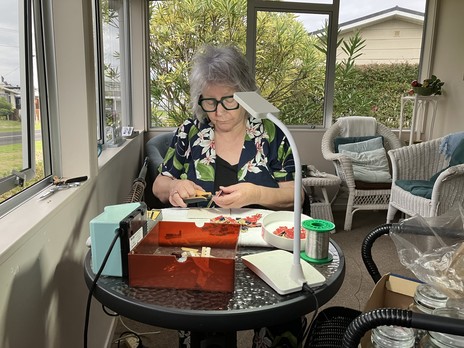Paul Crowther began designing and making pedals in his early days back in Dunedin. His band The Gentlemen were learning ‘On A Carousel’, a song The Hollies released in 1967. If you can’t get the exact sound you are looking for, and you have Paul Crowther in the band what do you do?
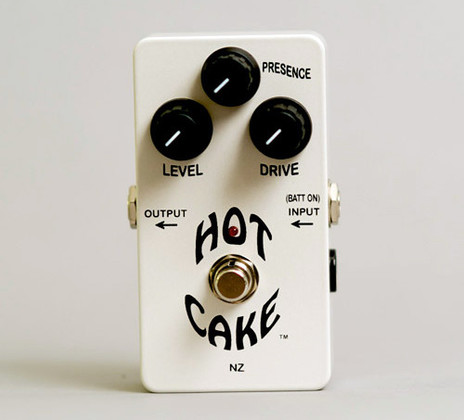
The Hotcake pedal, designed by Paul Crowther.
“It had kind of a banjo sound at the beginning, so I made a filter pedal with six different sounds.” The pedal was like the emerging wah-wah pedal. “I called it a Herbert – I still have it,” says Crowther.
“I also made fuzz pedals back then, the first from a magazine. I modified it, and quite quickly I realised it wasn’t as good as it could have been, so I simplified it and added more tones. I was into electronic organs and organ tone filters, so I knew a bit about them. My fuzz pedals didn’t have an attack control – that was controlled from the guitar. They just had three knobs, three level controls, and the three different tones, you could just mix them together.”
In London in 1976 as the drummer of Split Enz, with his days free, Crowther got to work thinking about how to improve the sounds for the band. “I made quite a neat octave divider for our sax player, and was always working on distortion pedal ideas. That’s when I had the Hotcake idea.
“I had made quite a big elaborate box for Phil Judd, which was distortion and another couple of sounds. One day I had an idea to make a little pre-amplifier circuit which had a completely flat response. It didn’t affect the tone, but when it distorted there is a tone filtering applied to just the distorted part, but not the clean aspect of the sound. I made it and thought – yeah that’s good, that’ll work!
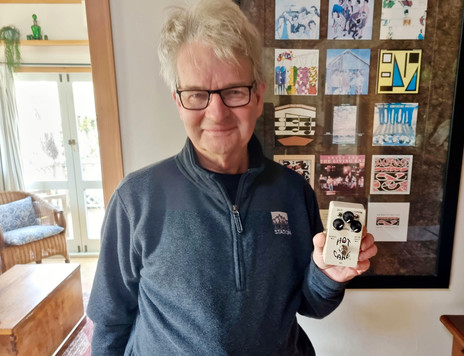
Paul Crowther with the Crowther Hotcake. - Gareth Shute
Crowther had a rethink on the circuit board, as he thought the resulting sound was a bit too slick for Phil’s guitar style. “He used distortion – but thought it was a bit too professional sounding for what he was doing – so I put an ordinary fuzz circuit back into his guitar. Then I built the circuit board into a box.”
Back in New Zealand, his stint in the Enz over, Crowther began making a few pedals for local musicians. “Waves guitarist Graham Gash had one of the very early pedals.”
Keen to return to playing drums, Crowther soon got a new band together. The group was brainstorming name ideas when Doug Rogers from Harlequin studios suggested The Hotcakes. Paul thought the name was perfect, but not for the band.
“That’s what I am going to call my pedals – The Hotcake! – Thanks! That is how the name came about. Named in 1977.”
The Hotcake, although now happily named, was still very much a sideline for Crowther. He continued doing front of house sound for bands while making pedals in his spare time. “I was just making them very casually at the time, just making them here and there. Split Enz was back in town, and by this time Neil [Finn] was in the band. He had a custom-made pedal he needed repairing, but I couldn’t do it quickly because all the parts were bogged up with epoxy! I gave him the Hotcake to try, and he bought one. He still has that original one. I sold a few to people touring from overseas, who would call me up and get one if they were in town. Much later on, I would go to the soundchecks of touring bands with a pedal for them to try.”
In my conversation with Paul, he mentioned that Shayne Carter had given a Crowther Hotcake to Kevin Shields, in 1990, when Straitjacket Fits toured with My Bloody Valentine in Australia. I wrote to Shayne and asked him if that was the case. “Yes, I got Kevin a Hotcake,” he replied. “He was a real gear /pedal dweeb, as you can probably tell from their records (lovely man). It’s the quintessential New Zealand effects pedal really. I’ve had one for so long, I still have the original design with plain unpainted metal and no writing on it. If I was a pedal dweeb myself, I’d describe it as a kick-ass distortion that doesn’t compromise the original tone of your instrument – unlike so many distortions that just blur it out. So you get plenty of warmth and crunch.”
So, even though Crowther was not marketing the Hotcake, the word spread, locally, and occasionally he would receive a letter from international guitarists who had heard the pedal or heard about it and needed to get their hands on one.
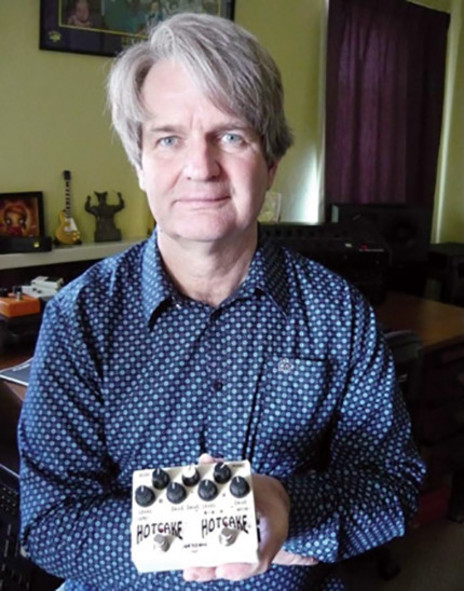
Paul Crowther with The Hotcake.
One of the first internationals to write to Paul seeking a Hotcake was US guitarist and composer Henry Kaiser, who wanted a pedal to add to his immense collection of guitars, amplifiers, and effect pedals, on his quest to achieve “sonic diversity”.
In 1994, after getting back home from a long and hard tour mixing sound for The Mutton Birds in Australia, Paul received a phone call from an American woman, Mrs Fisher, who was holidaying in New Zealand. Mrs Fisher’s son had heard about the pedal from Henry Kaiser and asked his mother to see if she could track down a Hotcake pedal while she was in Auckland. After visiting most of the music shops in Auckland, she was told to call Paul Crowther. “So she gave me a call, and I went and saw her, and took her down a Hotcake, and she said, ‘This is for my son Ken, he writes for a magazine called Vintage Guitar, and he also makes amplifiers called Trainwreck.’”
Fisher’s review created quite a buzz and stirred up a lot of interest in the Hotcake.
Back in the US, with the Hotcake safely delivered, Ken Fisher wrote about the pedal in his popular column in Vintage Guitar. Ken was considered to be a tube amp and sound guru, and no doubt was something of a kindred spirit to Crowther. Fisher’s review created quite a buzz and stirred up a lot of interest in the Hotcake. From his own experience making and selling his Trainwreck amplifiers, Ken had some “sound” advice for Paul.
“Ken gave me a call and said that this is a fantastic pedal, and I have had a few people suggesting that they would like to manufacture them. I think what you should advertise and make them yourself and just sell them directly. So I did that, I advertised in Vintage Guitar, and people would send an international money order cheque. I was selling quite a few that way.”
More mail orders and letters arrived at Crowther’s Mt Eden home and workshop, and one from Japan, in particular, led to a productive period.
Crowther makes the pedals with his wife Jo, who works on the circuit boards. Her work as a seamstress set her up with the patience and attention to the fine detail, and her input makes Jo a key part of the Crowther Audio Hotcake story.
Of all of Crowther’s stories, my favourite is the one about the beginnings of the Japanese Hotcake distribution: “I got a letter from Japan, from Hiroshi Yagi who has a company called Human Gear. He enquired about buying some pedals, and he asked me for a price. So I wrote back and said, I’ll give you a discount if you buy 10, and he sent an envelope full of 10,000 yen notes [approx $US100 each) and I sent him 10.”
Soon after that, while Crowther was away again with The Mutton Birds, another letter arrived from Japan. “He wrote back and said, we have sold out, please send 40! With an envelope with more 10,000 yen notes. So I organised to send him 40, and from then on he was ordering 60 every two months, for quite a long time. They were expensive in Japan. That kept us busy.”
Hotcakes for breakfast: Joanne Crowther assembling another unit. - Trilby Crowther
Crowther spent more time away in England with The Mutton Birds in 1995, and after a few months, he returned to another large order from Hiroshi Yagi. “He was my biggest customer for a long time, but things quietened down after the earthquakes in Japan. I still sell a lot to re-sellers. I also have an importer in England, but they are quite pricey by the time they have their mark-up put on them.”
Things were taking off for the Crowther Hotcake pedal, but he wanted to address feedback from a few people who were concerned about the “fizziness” at the onset of distortion.
“I know why it happens, but it was just inherent in the way the circuit works. So, over a weekend, I came up with a way around it. I modified the standard Hotcake circuit, and then I just carried on selling them, there was a subtle difference to the sound. I thought it was very subtle, but certain people could hear the difference.”
This modified version was the one he had been sending to Japan, and he was surprised when Hiroshi contacted him and said he had been getting enquiries about the original circuit Hotcake, and started ordering these instead of the modified version.
Crowther came up with further variations on the original pedal.
Now that there were two versions in current circulation, Crowther started labelling the pedals: “The old Circuit Hotcake and The Standard Hotcake. I realised I had to come up with a new name, I was calling it the Softedge for a while, but then I came up with the name Bluesberry, to save confusion.”
Always thinking of ways to improve and modify the Hotcake, Crowther came up with further variations on the original. A well-entrenched story in New Zealand music folklore is the fact that he decided to modify the pedal from the switch to a dial. This came about because Nigel Regan from Head Like a Hole kept on breaking them in his exuberant stage antics and was constantly taking them to Crowther to be repaired.
“Then I brought out the version with the variable tone, rather than just the switch tone. In Japan, that became known as the three-knob Hotcake. I then came up with a further modification so you could switch between the normal setting and the Bluesberry setting – which isn’t exactly the same, but very close, and I could do it with a single switch. So now there are a couple of switches inside the Hotcake, one switches from normal to the Bluesberry and one switch leaves the low end in, because people were also starting to use them for bass.”
Prunes & Custard
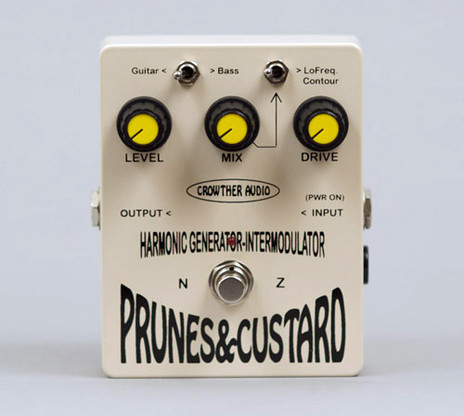
The Crowther Audio Prunes & Custard "Harmonic Generator-Intermodulator" pedal.
In 1995 Crowther was playing around with a computer programme and came up with another wave shaping circuit. With a few tweaks and re-visits (“I realised I had to use very close tolerance components to make it work properly, and I started making them”), the Prunes and Custard – Harmonic Generator-Intermodulator was born. “I called the first ones I made the Google Box. I liked the word Googly. So there’s a couple around, just with printing tape, which says Google Box. And then it became Prunes & Custard, and I gave it a sub-name, all in one word – Harmonic Generator-Intermodulator. I thought it sounded quite cool.
The Prunes & Custard is useful for guitar and bass. Crowther explains: “It is a two-stage circuit. There is a pre-amp stage, the gain of which is adjusted with the drive control. This stage is followed by a special wave-shaping distortion circuit. There is some treble roll-off between the pre-amp and the special distortion circuit. But it’s basically what any distortion does.”
The pedal was voted Overall Pedal of the Year by Guitar & Bass magazine in 2006 and inspired The Datsuns’ song and EP Harmonic Generator (2002).
The Double Hotcake
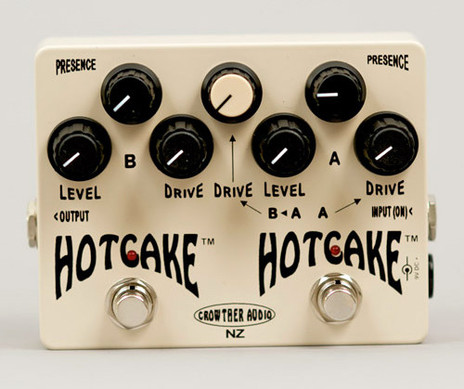
The Double Hotcake, designed and built by Crowther Audio.
Crowther says Double Hotcake users can thank a young Liam Finn for his frequent requests for a way to perfect and design two hotcakes into one unit. “I had been thinking of making a double version of the Hotcake, and a few people had mentioned it to me, but it was Liam Finn who asked, ‘Can you make two Hotcakes in the one box?’ He asked me a couple of times, and I said, okay – I’ll do it.”
Finally, Crowther knew what to do with that gap in the middle of the hotcake box. “I had room for an extra knob, and I spent ages deciding what to do with that extra space, and it dawned on me the best way to use it.”
The Double Hotcake is the first Hotcake and Bluesberry in one unit. “On the right is the Bluesberry circuit, and the second one is the original ‘normal’ circuit. Not switchable. What makes that one interesting is [that] when both sides are switched in, the A-side is driving the B-side, but the A’s controls aren’t used.
“The level and presence controls are pre-set so you can have a full-on distortion sound with the A Hotcake working on its own and have a relatively clean sound with them both on. You can also have a double tone boost, and you can get three different almost-clean sounds as well.”
Putting the dates into the Hotcake
The Hotcake pedal – and especially the older Hotcakes – are eagerly searched for and very collectable. The identifying markers visually are the change in switches, the font and pedal colour/paint.
The Fonts
“The font on the original Hotcake was from Mecanorma, and was called ‘Putty’. I then lost the artwork, so used a kind of Wild West printing, and then a friend of mine, Murray Hodge, designed the current font style.”
The Colours
“The first ones were done by Auckland Industrial Sprayers, this AIS brown was used because they had a lot available. They would spray it, then bake it. AIS closed down so I had to find a new company and colour. It is more of an almond colour and varies slightly. But it has a solid powder coat.”
The Switches
The original pedal doesn’t have the Presence and has just two sounds. Head like a Hole kept jumping on the whole pedal and broke the switch so I just put the variable control on there, I thought it might be a bit stronger. So I made a few like that.”
Serial Numbers
In 1994, Paul started labelling the pedals on the inside – making it much easier to identify the original manufacturing date: “The serial number is the year, the date and then how many for that month.
“I can still make any version of the original Hotcake. But we have the Hotcake, The Double Hotcake and the Prunes and Custard. I still make the old circuit with the switch tone for Japan.”
